In this video, we bring you some top tips on how to reverse your motorhome to avoid accidentally damaging your pride and joy and having to make a motorhome insurance claim.
Each year at Caravan Guard insurance we deal with many accidental damage claims as a result of a reversing mishap – whether that be into something like a gate post, overhanging trees or walls.
We speak to Richard, an experienced instructor from Towing Solutions in Macclesfield, for his hints and tips on reversing your motorhome onto a pitch, into a service bay or into a parking space.
How do you prepare yourself before starting to reverse your motorhome?
Firstly, it’s best to get out and have a look at the area you’re reversing your motorhome into so you can see if there are any obstacles in the way.
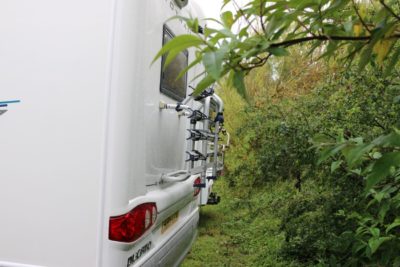
Remember, you’ll also likely have an overhang at the back of your motorhome, plus you might also have a bike rack, so if you’ve got someone with you, get them to stand behind the motorhome, where you can see and hear them so they can help guide you back.
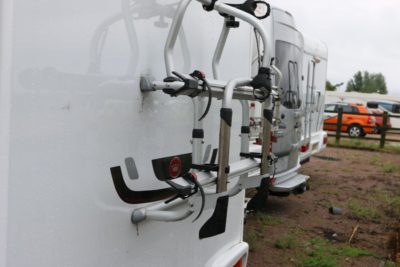
It’s good to know the dimensions of your motorhome and it’s worth having them handy – like on the sun visor of your vehicle, – not only for when you’re reversing but when you’re driving
normally, so you always know the height, width, and length of your motorhome. Caravan Guard motorhome customers can get a sticker like the below.
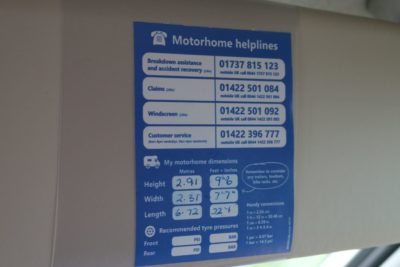
Your vehicle will also have a number of blind spots and you need to know where they are before reversing your motorhome. That’s why it’s helpful to always have someone with you, to help guide you back in and be an extra pair of eyes.
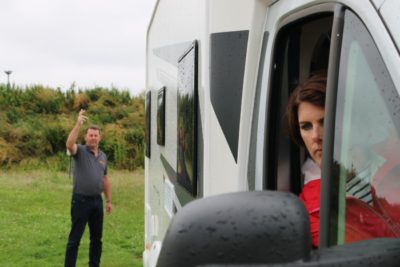
Also, if you have a reversing camera make sure that it’s switched on and you can clearly see what’s going on behind you.
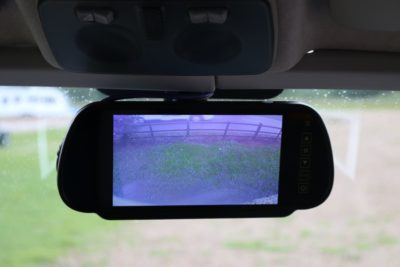
If you’re in a busy area it’s also advisable to use your hazard lights to let people know around you that you are backing up and just in case they haven’t spotted your reversing lights.
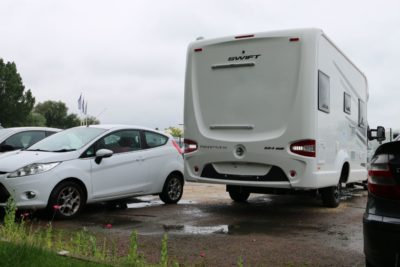
Finally, ignore anyone on the campsite who is watching you! They’ll be mighty impressed with your reversing skills anyway if you follow our tips below.
How do you reverse your motorhome in a straight line?
Take it slow, take it steady, and manoeuvre it safely.
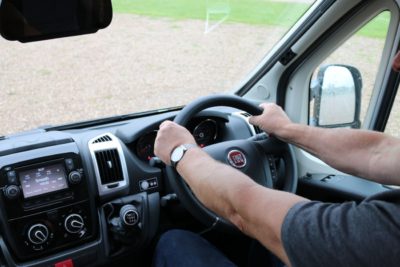
Put your hands at 2 o’clock and 10 o’clock on the motorhome steering wheel so you can gently move it left and right to manoeuvre it back in a nice straight line.
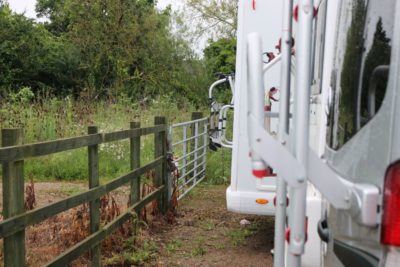
It’s always advisable to stop and get out and have a look and make sure that you’re in a straight line and you’re following the correct path.
How do you reverse your motorhome to the right?
When reversing right into a parking space or onto a pitch, drive past the pitch so you’re clear of it. Then check around the area you’re backing into to make sure there’s no one around and it’s safe. If you’ve got someone with you, get them to help guide you back.
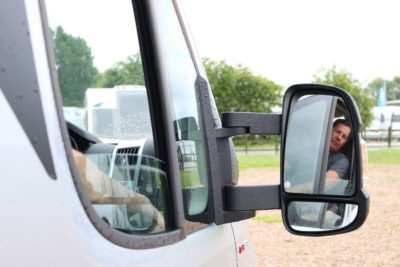
Check your mirrors, and if you’ve got a reversing camera watch that before slowly moving back.
The pivot point on a motorhome is your rear wheel axle, so as you go back you want to guide that axle to the point where you know you need to make your large turn.
Slowly reverse your motorhome to the right and then when you hit that pivot point fully lock the steering wheel to turn your motorhome into the space. If needs be, you might need to pull forward a little bit just to straighten it up.
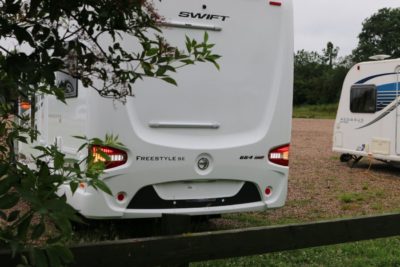
Be mindful that when reversing on to a pitch the ground might be uneven, so bear in mind any overhang behind your motorhome’s rear axle and make sure you don’t catch that on any obstacles like a tree stump, post, raised stones or fencing.
How do you reverse your motorhome to the left (your blindside)?
When you’re reversing on your blindside it can be slightly more difficult because visibility is not as good as on the driver’s side. Again, drive past where you’re going to be, stop and again if you’ve got someone with you get them to go and stand in a position where you can clearly see them and hear them. Use your mirrors and reversing camera (if you’ve got one) and gradually move back slowly.
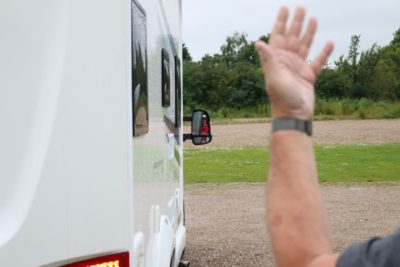
Look through the left mirror at the rear wheel, as this your pivot point, ad when you get near to where you want to turn, fully turn the steering wheel to the left to swing the motorhome into the bay or onto a pitch.
Richard said when reversing your motorhome it was absolutely critical that you use your mirrors.
“That’s the only way you’re going to be able to judge where you are. So the correct setting of those mirrors is critical,” he said. “Personally, I like one mirror showing me where my rear wheels are, so I can clearly see them. But that’s not just for reversing. I also do that for going forwards as well, particularly for when going around roundabouts and sharp corners to avoid clipping
any of these wheels on a curb. ”
What gadgets can help with when reversing your motorhome?
There are a number of motorhome reversing aids, such as reversing or rear view cameras, parking sensors and also add-on mirrors to help cover those blind spots.
“But you must remember to take notice of any bleeps or sounds from these gadgets,” added Richard. “The beeps sound for a reason and you need to stop your reversing manoeuvre at that point.”
And remember, at Caravan Guard we offer a small motorhome insurance discount for fitting a reversing aid such as parking sensors or a rear-view camera.
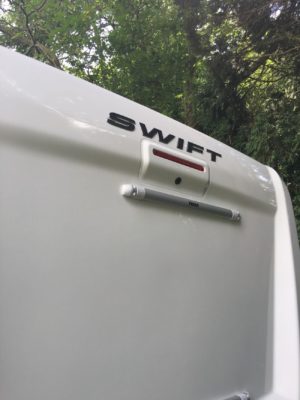
Five top tips for reversing your motorhome
- Stop and check your surroundings. Look at where you’re going to reverse and check for overhanging branches, tree stumps, any objects on the floor that could impede your reversing manoeuvre.
- Use some help. If you’ve got someone with you, get them to go out and be at the back of the vehicle where you can see them and hear them so that as you reverse your motorhome, you’ve got an extra pair of eyes. Or, if you’ve got a motorhome reversing camera or sensors fitted, use those. If the sensors start bleeping, take note of those, and stop!
- Know the overall dimensions of your motorhome. It’s a lot larger than your standard family car. We’d suggest having the height, width and length of your motorhome, in both metric and imperial, close to hand in the cab. It’s particularly useful when driving and you come across a bridge to quickly know your height and width restrictions as you don’t have time to guess. Also, consider any extra fittings at the back of your motorhome or on the roof. A cycle rack bolted on the back will extend the area that you need at the back to reverse onto a pitch, or you might have a satellite dish on the roof, which will increase the height of your vehicle, so you need to watch out for overhanging branches or height barriers.
- Use your mirrors. Often, you can’t see out of the back of your vehicle so you need to use your mirrors at all times. Make sure these are set correctly before you start your to reverse your motorhome.
- Reverse slowly. Taking it slowly gives you the opportunity to correct any errors. There’s no need to rush. Do it slowly and safely.
And finally, lots of practice will give you that extra confidence for reversing your motorhome like a pro. There are plenty of motorhome driving courses available nationwide if you need that extra bit of help.
Over to you…
Got any motorhome reversing tips to share? Feel free to add them to the comments box below.


If you keep one hand at the bottom of the steering wheel and move it to the right (6 o’clock to 3 o’clock) you turn that way and left to turn left. Main thing is take it SLOWLY. Even if you end up doing a 10 point manoeuvre, so what!! Slow and safe and keep looking all around
Some good advice, could I have a motorhome dimensions sticker please
On another manoeuvring issue, this time when moving forwards. Since the rear wheel of your motorhome is the pivot point, remember that when pulling forwards from between 2 vehicles or obstacles, there will be an amount of “backswing” to be accounted for, so always leave room for this. Backswing is the distance that the rear corner of your vehicle moves to the side opposite the direction of travel. I. E. If you are exiting a space to the left, using lefthand steering, the backswing will take the rear right hand corner out to the right of the space. The longer the overhang beyond the rear wheels, the greater the backswing distance will be. Always plan your parking position to take account of which way you will exit your space to ensure that you have room for the backswing as you leave. Happy motoring to all.
Good tips, can I have one of the stickers please for dimensions.
Brilliant tips, as i’m usually the one at the back waving my arms and shouting ‘stop !’
Please can you send me the measurement sticker, many thanks.
Great tips …. How do I get a sticker to write the measurements on?
Hi Judith, we have a small supply available. I have emailed you directly. Thanks Liz
When we got our Motorhome the first thing we did was to get front and rear reversing sensors put on. I don’t know why these don’t come either as standard or as an option for Motorhomes as these days most new cars and vans have them as standard.
Where can we get the sticker from to put on the visor to write the height etc please?
Hi Madeline I’ve sent you an email. Liz
try not to park on kerbs as motorhomes especially long ones flex and you will find if you flex the motorhome chassis too much you will not be able to open the habitation door
From our experience I would endorse concern about branches mentioned on the video but not included in the summary.
I would stress that on full lock the cab moves two metres or so away from the turn which needs to be taken account of. This is not mentioned.
A Walkie talkie linking the driver to the banksman can be a lot better than arm waving: just need to establish a conversation about all the banksman can see.
Too much of the article assumes a camspite situation not a stressful road or ferry. Need to practice for these and insist that you will take time for proper preparation and proceed at slow speed (as mentioned).
Whatever you decide on, make sure you and your co-pilot have a common understanding of the hand signal(s) being used used.
In the data for the vehicle, which you should always have instantly visible in the cab, is the WEIGHT, in tonnes and kg, as there are often weak bridges which you risk damaging. Width is not the only limit on some of our beautiful old bridges!
A very good point John.
One essential thing is missing, keeping an eye on your front wing when turning the steering wheel to avoid hitting low or other initially hidden hazards to the side eg bollards, kerbs ditches etc.
Thanks for adding this great piece of advice Sid.
Train your co-pilot to avoid the two common errors in guiding you back.
1) It doesn’t matter how much they wave at you to stop if they have stood where you cant see them. Your co-pilot needs to stand where they can see the part of the van that needs watching AND where you can clearly see them.
2) It is not particularly helpful to wave you back until you are about to hit something then signal you to stop. Chances are you are thinking about more than just the one thing they are looking at. If at the point they suddenly change from the keep going to the stop signal, you are looking at one of the other mirrors you could be in trouble. If your co-pilot holds their hands apart by the distance you have left and brings them together at the rate you are closing the gap, that is the perfect information. It enables you to forecast when you will need to stop, not just instantly react to a sudden stop signal. You can then decide whether you need to go tight to the obstruction or whether the front is already far enough back that you can leave yourself plenty of room to walk around the back. You can also decide to stop with a couple of feet to spare to put the levelling ramps down so will be in the right place when you are up on the ramp; otherwise you will have to move the van again later. Showing you the distance you have left is far more helpful than any other signal.
Thanks for your top tips Ian.